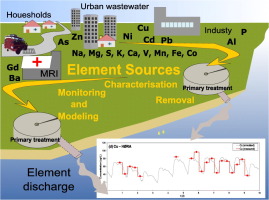当前位置:
X-MOL 学术
›
Sci. Total Environ.
›
论文详情
Our official English website, www.x-mol.net, welcomes your feedback! (Note: you will need to create a separate account there.)
Monitoring and modelling of influent patterns, phase distribution and removal of 20 elements in two primary wastewater treatment plants in Norway.
Science of the Total Environment ( IF 9.8 ) Pub Date : 2020-04-06 , DOI: 10.1016/j.scitotenv.2020.138420 Julia Farkas 1 , Fabio Polesel 2 , Marianne Kjos 3 , Patricia Almeida Carvalho 3 , Tomasz Ciesielski 4 , Xavier Flores-Alsina 5 , Steffen Foss Hansen 2 , Andy M Booth 1
Science of the Total Environment ( IF 9.8 ) Pub Date : 2020-04-06 , DOI: 10.1016/j.scitotenv.2020.138420 Julia Farkas 1 , Fabio Polesel 2 , Marianne Kjos 3 , Patricia Almeida Carvalho 3 , Tomasz Ciesielski 4 , Xavier Flores-Alsina 5 , Steffen Foss Hansen 2 , Andy M Booth 1
Affiliation

|
Many small- or medium-sized communities in Northern Europe employ only primary wastewater treatment plants (WWTPs) and effluent discharges can be a relevant source of pollution. The current study combines monitoring and modelling approaches to investigate concentrations, influent patterns, size distribution and removal of 20 elements for the two primary WWTPs (Ladehammeren, LARA; Høvringen, HØRA) serving Trondheim, the third largest city in Norway. Element concentrations were determined in raw influent wastewater, effluents and biosolids, and diurnal inflow patterns were assessed. The elemental distribution in particulate, colloidal and dissolved fractions of untreated wastewater was characterized using filtration separation and electron microscopy. An influent generator model and multivariate statistical analyses were used to determine release patterns and to predict the (co-)occurrence of selected elements. Raw influent wastewater concentrations for most elements were similar in the two WWTPs, with only Ca, Mn, Fe, Co and Ba being significantly higher (p < 0.05) in HØRA (which receives more household and hospital discharges). Removal efficiencies varied between elements, but in most cases reflected their association with particulates. Nanosized particles of several elements were detected, with Cu/Zn being most common. Measured concentrations of most elements followed typical diurnal wastewater discharge patterns and enrichment factors calculated for biosolids confirmed the importance of anthropogenic sources for P, Cu, Zn, Cd, As, Cr, Ni, Pb, V, Co and Fe. Elemental concentrations generally correlated well with total suspended solid (TSS) concentrations at HØRA, while this was less pronounced in LARA (possibly due to higher industrial contributions). In one of its first applications for WWTP influent pattern examination, principal component analysis was found to be instrumental for source identification of target elements, showing significant differences between LARA and HØRA influents. The combined experimental, statistical and modelling approaches used herein allowed for improved understanding of element sources, patterns of discharge and fate in primary WWTPs.
中文翻译:

挪威两个主要废水处理厂的进水模式,相分布和20种元素的去除的监测和建模。
北欧许多中小型社区仅使用初级废水处理厂(WWTP),而废水排放可能是相关的污染源。当前的研究结合了监测和建模方法,以研究服务于挪威第三大城市特隆赫姆的两个主要污水处理厂(拉德汉默伦,拉拉;霍夫林根,霍拉)的浓度,进水模式,尺寸分布和去除20种元素。确定了原始进水,废水和生物固体中的元素浓度,并评估了日间进水模式。使用过滤分离和电子显微镜对未经处理的废水中颗粒,胶体和溶解部分中的元素分布进行了表征。流入发生器模型和多元统计分析用于确定释放模式并预测所选元素的(共)发生。在两个污水处理厂中,大多数元素的原始进水废水浓度相似,在HØRA中(接收更多的家庭和医院污水),只有Ca,Mn,Fe,Co和Ba显着较高(p <0.05)。去除效率因元素而异,但在大多数情况下反映出它们与颗粒的关系。检测到多种元素的纳米颗粒,其中最常见的是Cu / Zn。大多数元素的测量浓度遵循典型的日间废水排放模式,计算出的生物固体富集因子证实了人为来源的P,Cu,Zn,Cd,As,Cr,Ni,Pb,V,Co和Fe的重要性。元素浓度通常与HRA的总悬浮固体(TSS)浓度相关,而在LARA中则不太明显(可能是由于较高的工业贡献)。在污水处理厂进水模式检查的首批应用之一中,发现主成分分析有助于目标元素的来源识别,显示了LARA和HØRA进水之间的显着差异。本文使用的实验,统计和建模方法相结合,可以更好地了解主要污水处理厂的元素来源,排放方式和命运。主成分分析被发现有助于目标元素的来源鉴定,显示了LARA和HØRA进水之间的显着差异。本文使用的实验,统计和建模方法相结合,可以更好地了解主要污水处理厂的元素来源,排放方式和命运。主成分分析被发现有助于目标元素的来源鉴定,显示了LARA和HØRA进水之间的显着差异。本文使用的实验,统计和建模方法相结合,可以更好地了解主要污水处理厂的元素来源,排放方式和命运。
更新日期:2020-04-08
中文翻译:

挪威两个主要废水处理厂的进水模式,相分布和20种元素的去除的监测和建模。
北欧许多中小型社区仅使用初级废水处理厂(WWTP),而废水排放可能是相关的污染源。当前的研究结合了监测和建模方法,以研究服务于挪威第三大城市特隆赫姆的两个主要污水处理厂(拉德汉默伦,拉拉;霍夫林根,霍拉)的浓度,进水模式,尺寸分布和去除20种元素。确定了原始进水,废水和生物固体中的元素浓度,并评估了日间进水模式。使用过滤分离和电子显微镜对未经处理的废水中颗粒,胶体和溶解部分中的元素分布进行了表征。流入发生器模型和多元统计分析用于确定释放模式并预测所选元素的(共)发生。在两个污水处理厂中,大多数元素的原始进水废水浓度相似,在HØRA中(接收更多的家庭和医院污水),只有Ca,Mn,Fe,Co和Ba显着较高(p <0.05)。去除效率因元素而异,但在大多数情况下反映出它们与颗粒的关系。检测到多种元素的纳米颗粒,其中最常见的是Cu / Zn。大多数元素的测量浓度遵循典型的日间废水排放模式,计算出的生物固体富集因子证实了人为来源的P,Cu,Zn,Cd,As,Cr,Ni,Pb,V,Co和Fe的重要性。元素浓度通常与HRA的总悬浮固体(TSS)浓度相关,而在LARA中则不太明显(可能是由于较高的工业贡献)。在污水处理厂进水模式检查的首批应用之一中,发现主成分分析有助于目标元素的来源识别,显示了LARA和HØRA进水之间的显着差异。本文使用的实验,统计和建模方法相结合,可以更好地了解主要污水处理厂的元素来源,排放方式和命运。主成分分析被发现有助于目标元素的来源鉴定,显示了LARA和HØRA进水之间的显着差异。本文使用的实验,统计和建模方法相结合,可以更好地了解主要污水处理厂的元素来源,排放方式和命运。主成分分析被发现有助于目标元素的来源鉴定,显示了LARA和HØRA进水之间的显着差异。本文使用的实验,统计和建模方法相结合,可以更好地了解主要污水处理厂的元素来源,排放方式和命运。


























 京公网安备 11010802027423号
京公网安备 11010802027423号